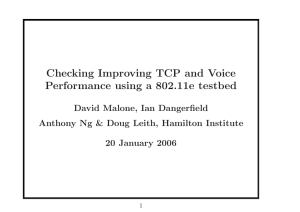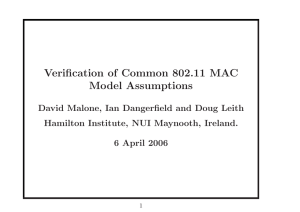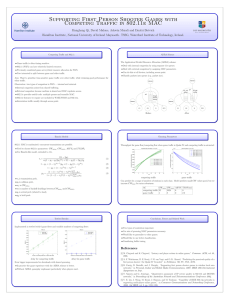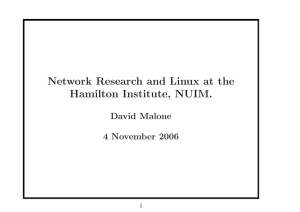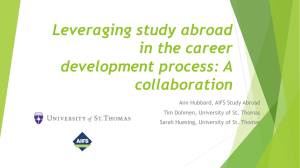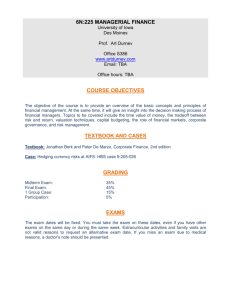Experimental Evaluation of 802.11e EDCA for Enhanced Voice over WLAN Performance
advertisement
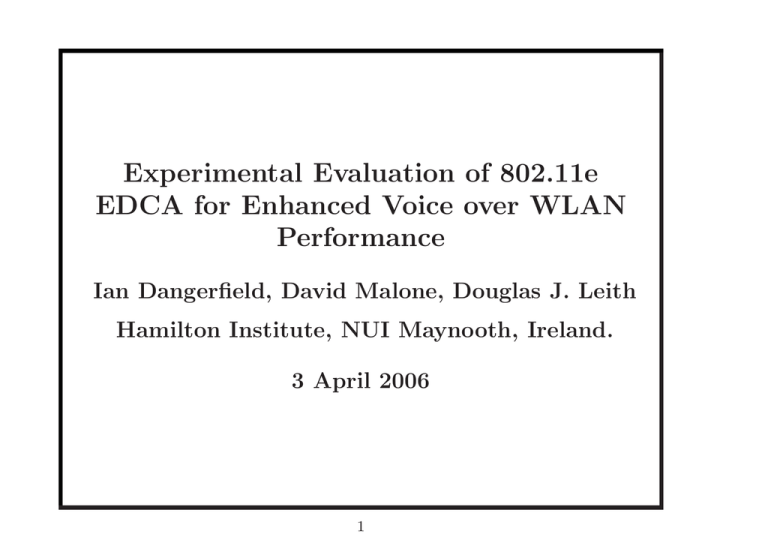
Experimental Evaluation of 802.11e EDCA for Enhanced Voice over WLAN Performance Ian Dangerfield, David Malone, Douglas J. Leith Hamilton Institute, NUI Maynooth, Ireland. 3 April 2006 1 802.11(e) MAC Summary • After TX choose rand(0, CW − 1). • Wait until medium idle for DIFS(50µs), • While idle count down in slots (20µs). • TX when counter gets to 0, ACK after SIFS (10µs). • If ACK then CW = CWmin else CW∗ = 2. Ideally produces even distribution of packet TX. In 11e have multiple queues. Each has own CWmin , DIFS(aka AIFS) and can have TXOP. 2 Why use a testbed? • Can we believe ns? Bugs: aCCATime, virtual collisions. • Can we believe the standard? • Can we believe models? • What are the practical issues? 3 Testbed setup Multiple STA (Linux) connected to AP (Linux hostap). Hardware model spec 1× AP Dell GX 260 2.66Ghz P4 18× STA Soekris net4801 266Mhz 586 1× STA Dell GX 270 2.8Ghz P4 WLAN NIC D-Link DWL-G520 Atheros AR5212 External antenna, PCI interface, Madwifi driver with local patches for 11e parameter setting. MGEN and iperf used for traffic generation. 4 5 Practical Issue: Calibration UDP up TCP up 11 STAs Upload To AP UDP 11 STAs Upload To AP 700 1500 600 Throughput(kbits/sec) Throughput(kbits/sec) 500 400 300 1000 500 200 100 0 1 2 3 4 5 6 STA id 7 8 9 10 0 11 Small changes until well behaved. 6 1 2 3 4 5 6 STA id 7 8 9 10 11 Validation Relative Throughput against TXOP parameter Relative Throughput against AIFS parameter 5.5 30 Analytical Model Experimental Results 5 25 4 Relative Throughput Relative Throughput 4.5 3.5 3 2.5 20 15 10 2 5 1.5 1 0 1000 2000 3000 4000 TXOP in unit of us 5000 6000 0 7000 Relative Throughput against CWmin Analytical Model Experimental Results 16 Relative Throughput 14 12 10 8 6 4 2 0 −3 −2 −1 0 1 2 3 CWmin Shift (0 corresponds to the default CWmin 32) 5 10 15 AIFS in unit of 20us timeslot 20 25 Measure relative performance of two saturated flows while varying TXOP, AIFS and CWmin . Compare to well-known models. 20 18 0 4 7 Voice • Has a loss and delay requirement. • Low rate vs. high rate. • Aim to protect voice from saturated sources. • AIFS is the obvious parameter. • For sake of argument, target loss of 10%. • (simulation says 4, model says 6 to be safe). 8 Unprioritised Voice Throughput Delay 70 30000 60 Average Delay (seconds x 10-6) 25000 50 Throughput (kbps) Unpriotised Station Delay bound for queue stability 40 30 20 20000 15000 10000 5000 10 Unpriotised Station Ideal Throughput 90% Throughput 0 0 2 4 6 0 8 10 12 14 16 18 0 Number of competing stations 2 4 6 8 10 12 Number of competing stations Rapid drop in throughput. Linear growth in delay. 9 14 16 18 Measuring Delay • Want to measure one-way MAC delay. • NTP slow and insufficiently accurate. • Simultaneously observable TX better, largish noise. 0.1 station 1 station 2 station 3 station 4 Offset (s) 0.05 0 -0.05 -0.1 0 500 1000 1500 Time (s) 10 2000 2500 Delay Technique • Transmission not complete until MAC ACK. • Hardware supports interrupt after ACK. Interface TX Queue 1. Driver notes enqueue time. Driver 4. Driver notes completion time. Driver TX Discriptor Queue 2. Hardware contends until ACK received Packet transmitted Hardware ACK received 11 3. Hardware interrupts driver. Validation 1600 Median delay (seconds x 10-6) 1400 1200 1000 800 600 400 Long preamble Fit line: 11.0012Mbps x + 484.628us Short preamble Fit line: 11.0016Mbps x + 292.565us 200 0 0 200 400 600 800 1000 1200 Packet size (bytes, excluding headers) 12 1400 4000 16000 1400 1400 3500 14000 600 1500 400 1000 Mean delay (us) 800 2000 Throughput x delay (bytes) Mean delay (us) 1000 2500 1200 12000 0 500 0 1000 1500 2000 2500 3000 3500 4000 4500 1400 Mean delay (us) 1000 25000 800 20000 600 15000 400 10000 200 5000 Throughput x Mean delay (Station 2) Mean delay (Station 2) 300 400 CWmin value second station 500 0 600 Throughput x delay (bytes) 1200 30000 200 2 4 6 0 8 10 AIFS value of second station 35000 100 200 Throughput x Mean delay (Station 2) Mean delay (Station 2) 0 40000 0 400 0 TXOP value for station 1 0 600 6000 2000 Throughput x Mean delay (Station 1) Mean delay (Station 1) 0 800 8000 4000 200 500 1000 10000 Throughput x delay (bytes) 1200 3000 Measure relative performance of two saturated flows while varying TXOP, AIFS and CWmin . Check Throughput * delay has expected value. 13 AIFS Impact Throughput Delay 70 30000 60 Average Delay (seconds x 10-6) 25000 50 Throughput (kbps) Unpriotised Station Competitors AIFS = 4 Competitors AIFS = 6 Delay bound for queue stability 40 30 20 Unpriotised Station Competitors AIFS = 4 Competitors AIFS = 6 Ideal Throughput 90% Throughput 10 0 0 2 4 6 20000 15000 10000 5000 0 8 10 12 14 16 18 0 Number of competing stations 2 4 6 8 10 12 Number of competing stations Delay now practically bounded. AIFS 4 is enough, but on boundary. 14 14 16 18 Delay Distribution AIFS 0 AIFS 6 100 Percentage of packets (less than associated delay) Percentage of packets (less than associated delay) 100 80 60 40 1 competing station 6 competing stations 12 competing stations 18 competing stations Interpacket time 20 0 0 20000 40000 60000 80000 80 60 40 1 competing station 6 competing stations 12 competing stations 18 competing stations Interpacket time 20 0 100000 Delay (seconds x 10-6) 0 20000 40000 60000 Delay (seconds x 10-6) 15 80000 100000 Autocorrelation 1 Unpriotized, 1 competing station Unpriotized, 6 competing stations Unpriotized, 12 competing stations Unpriotized, 18 competing stations AIFS = 4, 1 competing station AIFS = 4, 6 competing stations AIFS = 4, 12 competing stations AIFS = 4, 18 competing stations AIFS = 6, 1 competing station AIFS = 6, 6 competing stations AIFS = 6, 12 competing stations AIFS = 6, 18 competing stations 0.8 autocorrelation 0.6 0.4 0.2 0 -0.2 0 5 10 15 number of packets 16 20 25 30 Conclusions • Small 11e testbed. • Hardware seems to behave as expected. • Instrumented to fine-grained MAC delay. • 11e can be used to help voice out. • Look at mixed voice/data and voice only networks. 17 Thanks David.Malone@nuim.ie http://www.hamilton.ie/ 18
